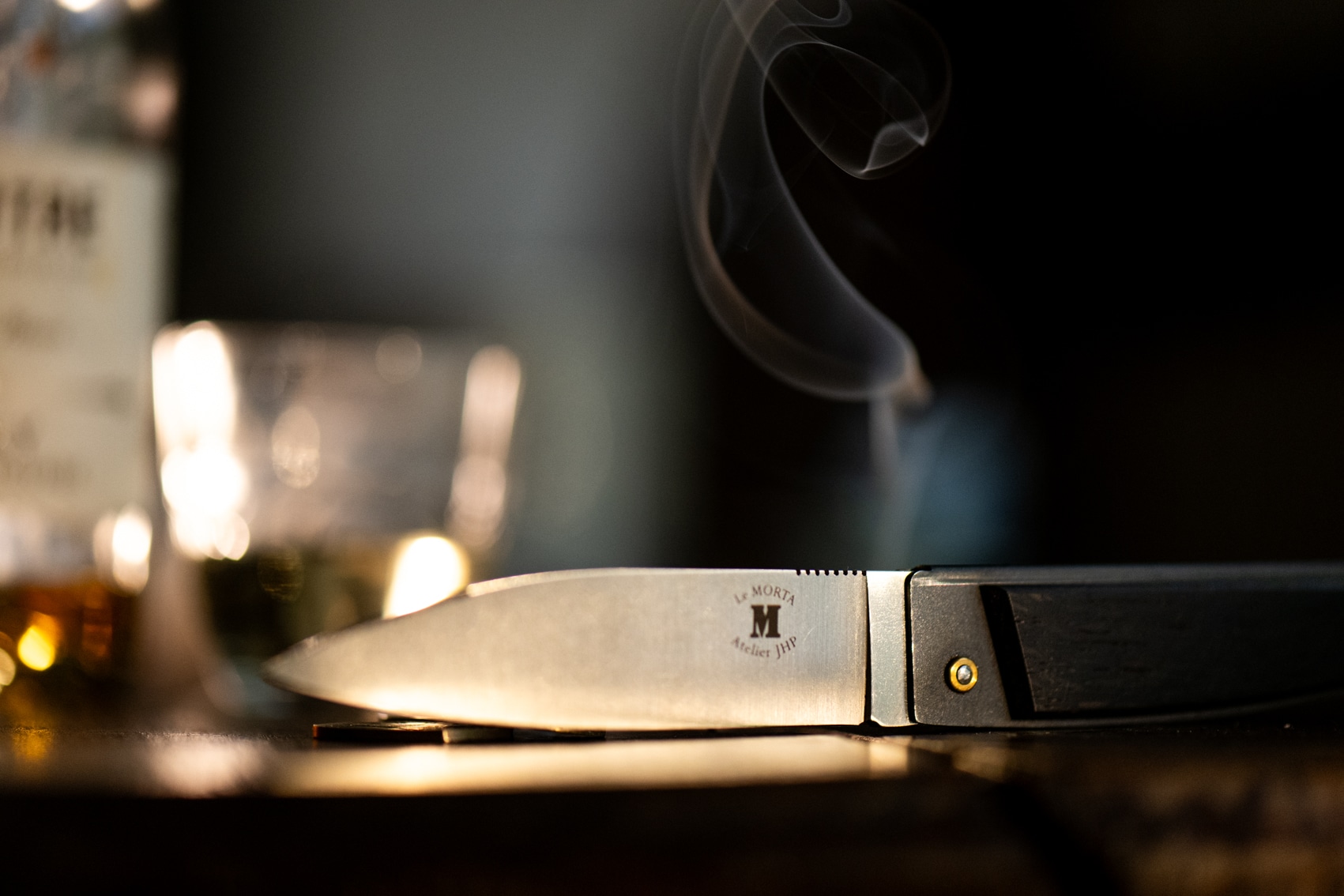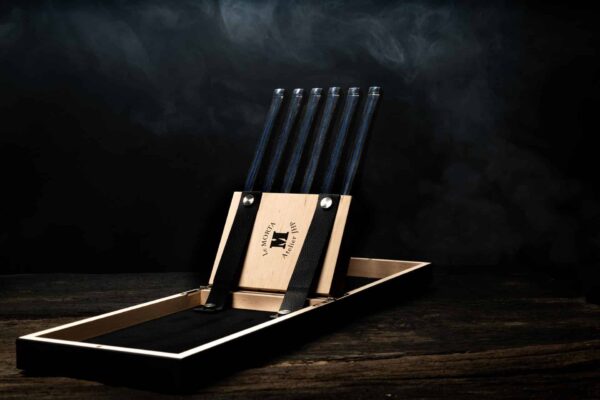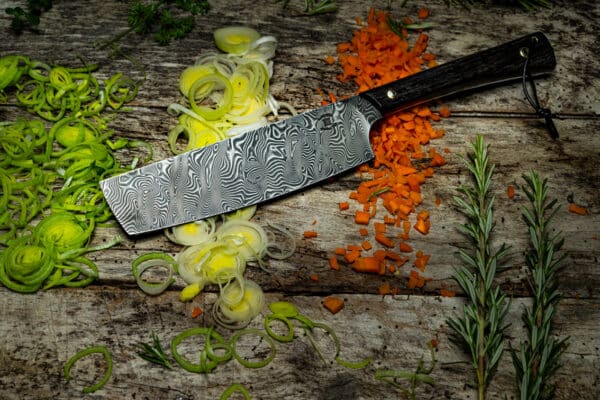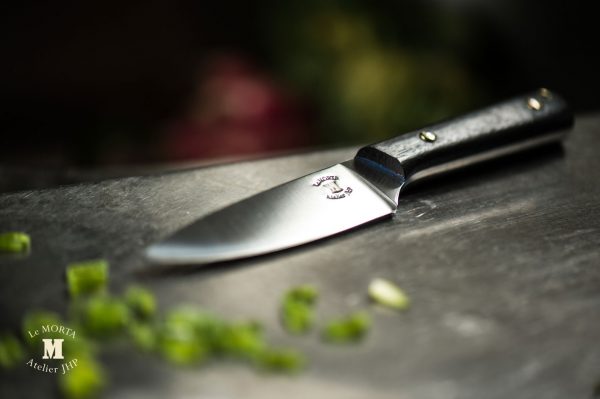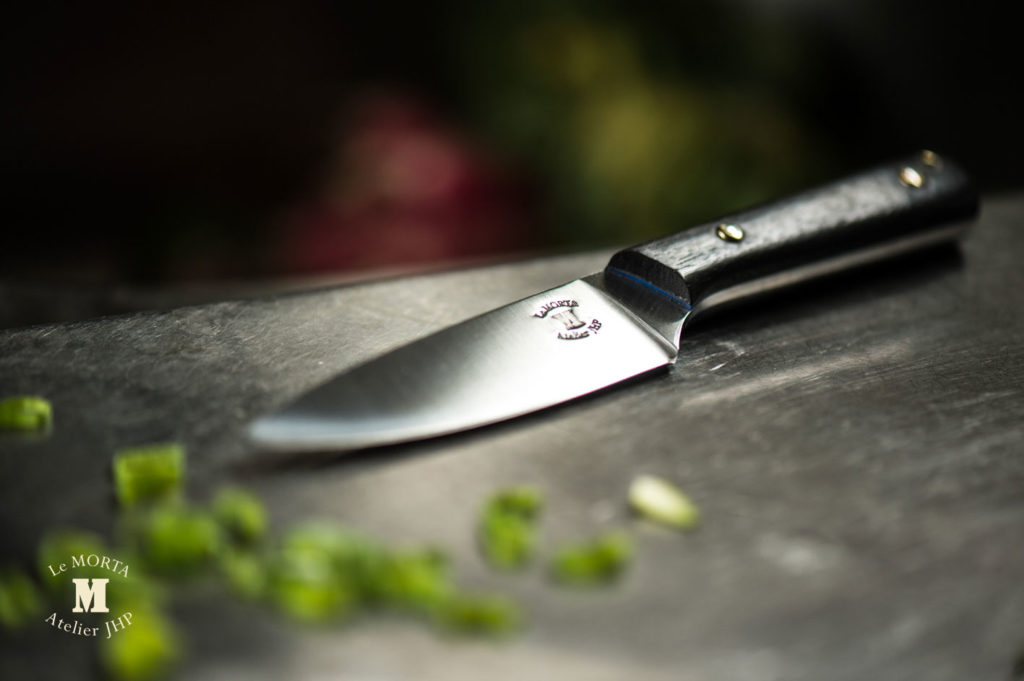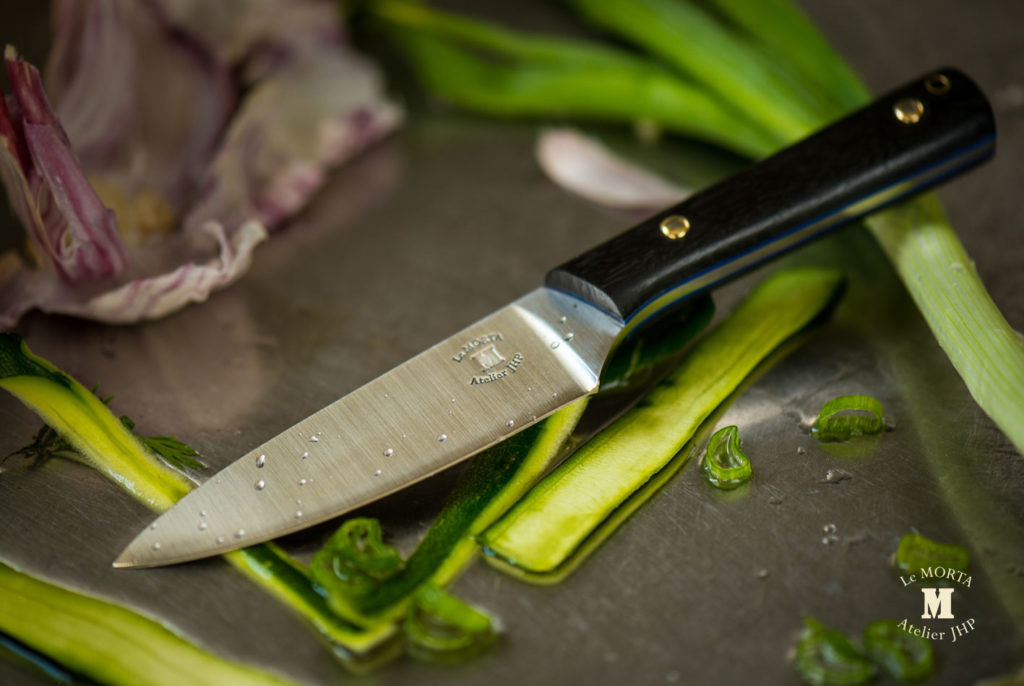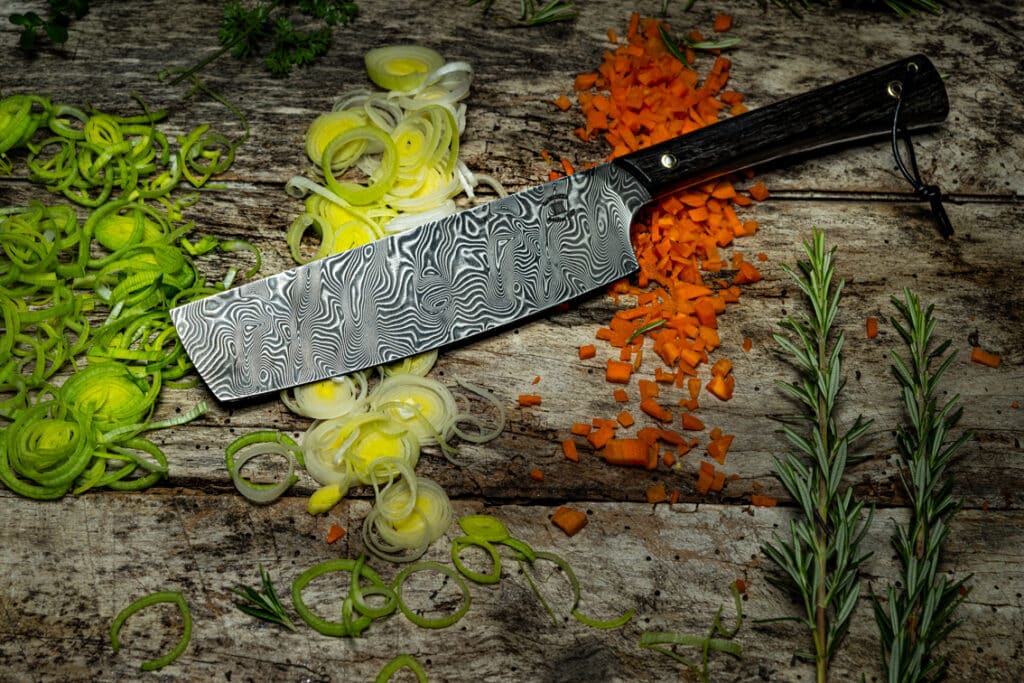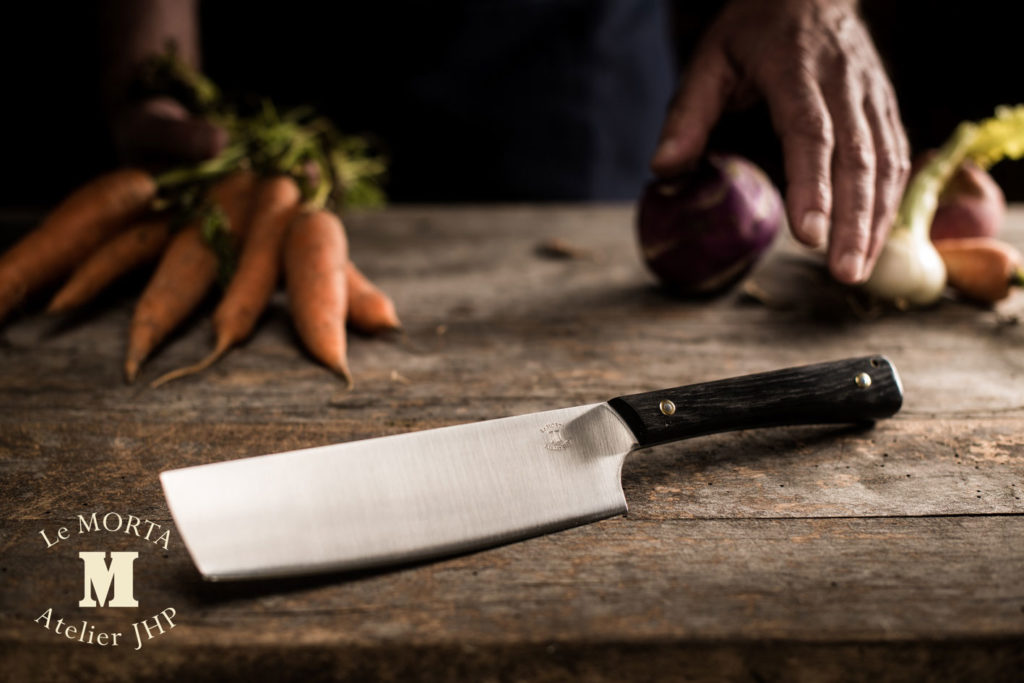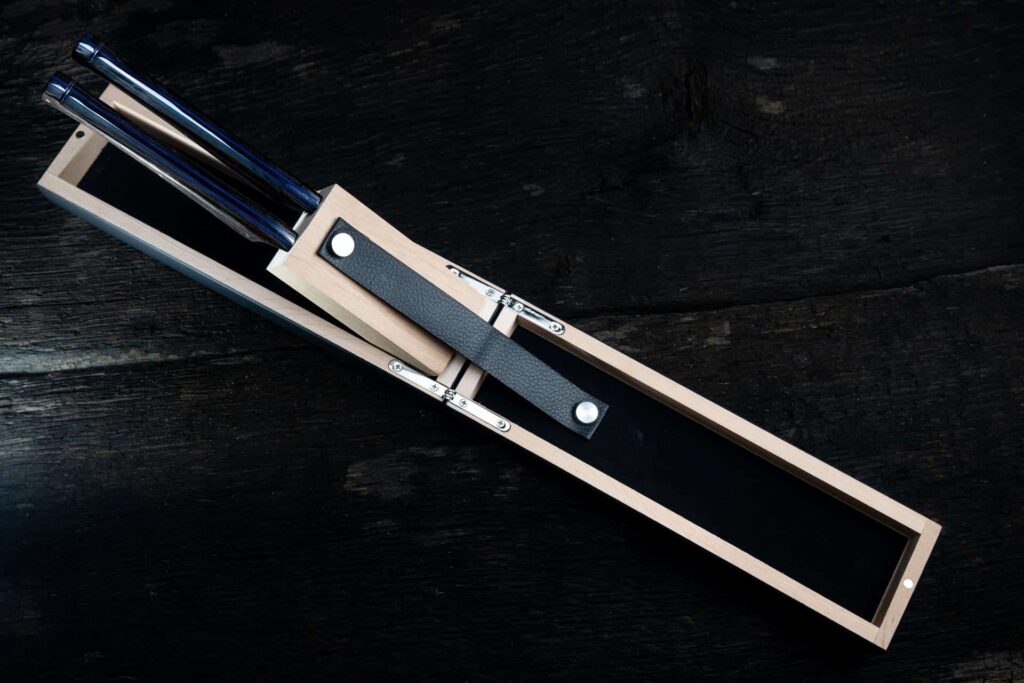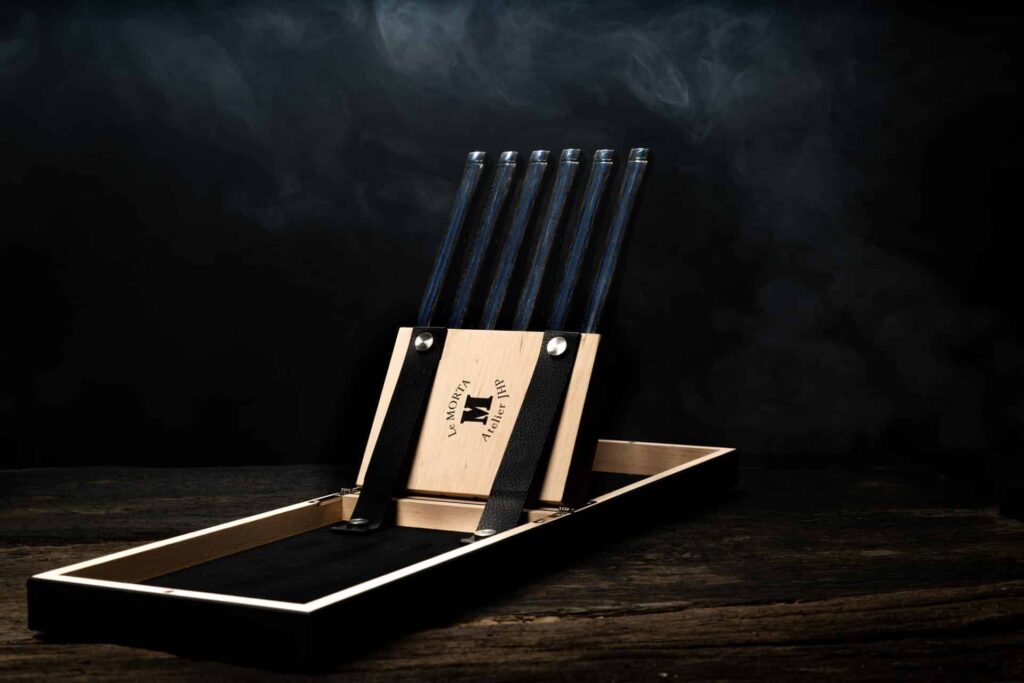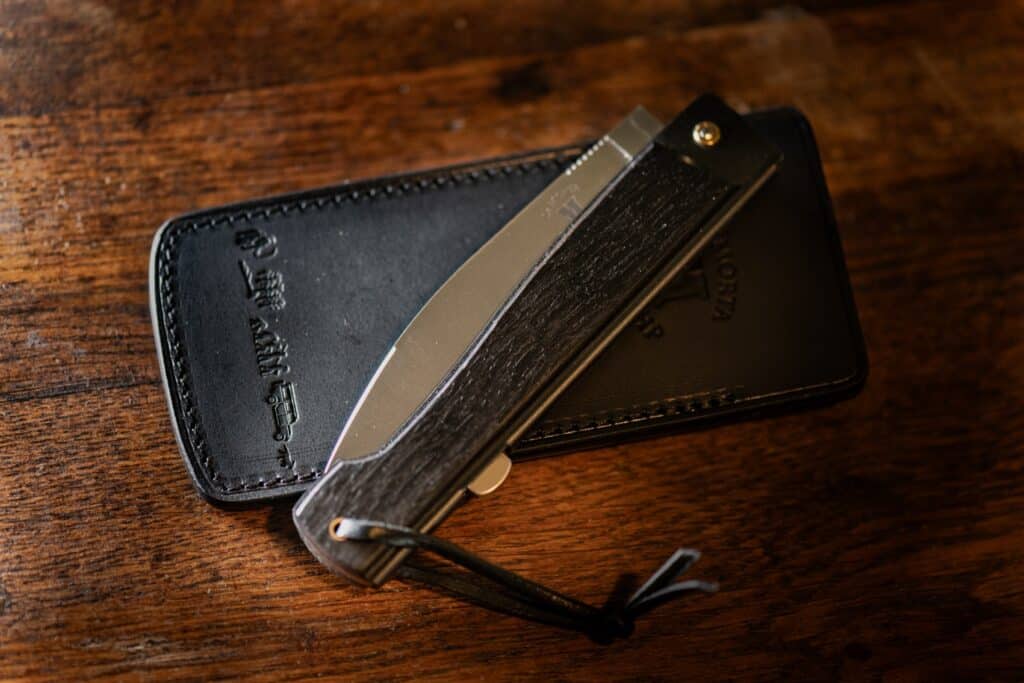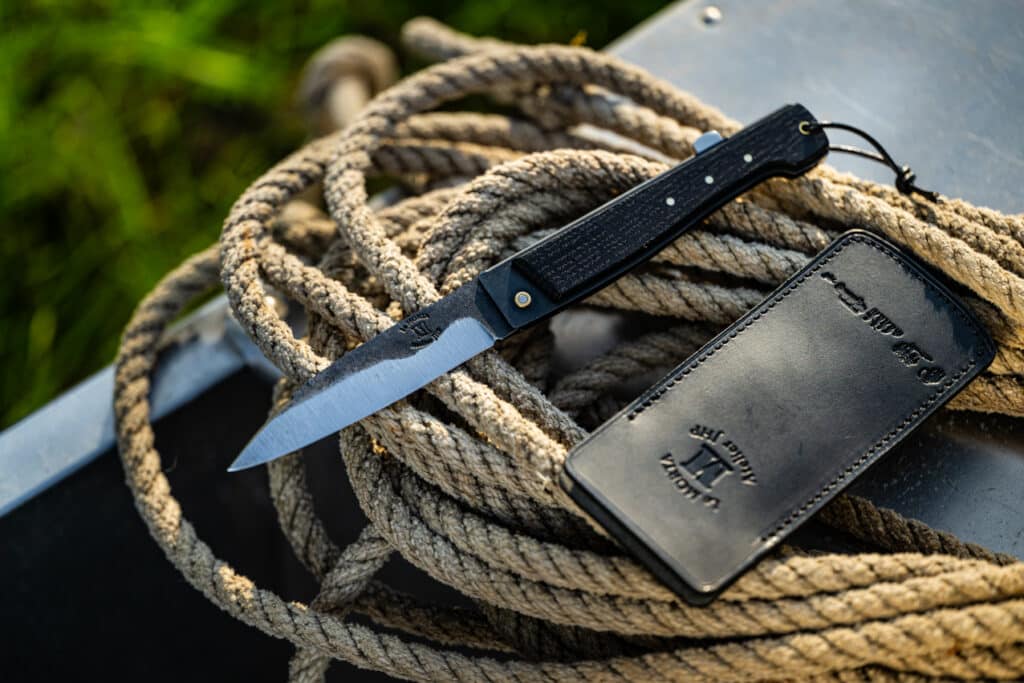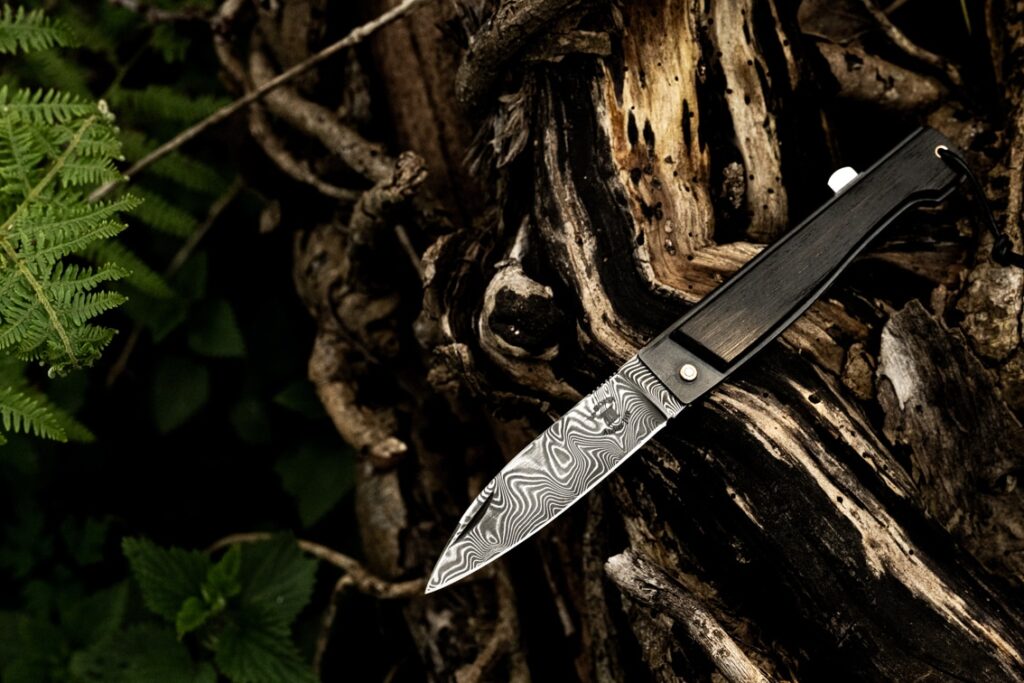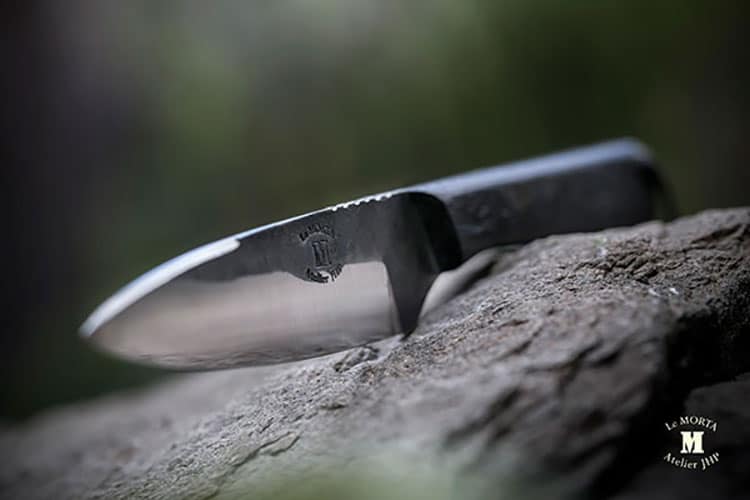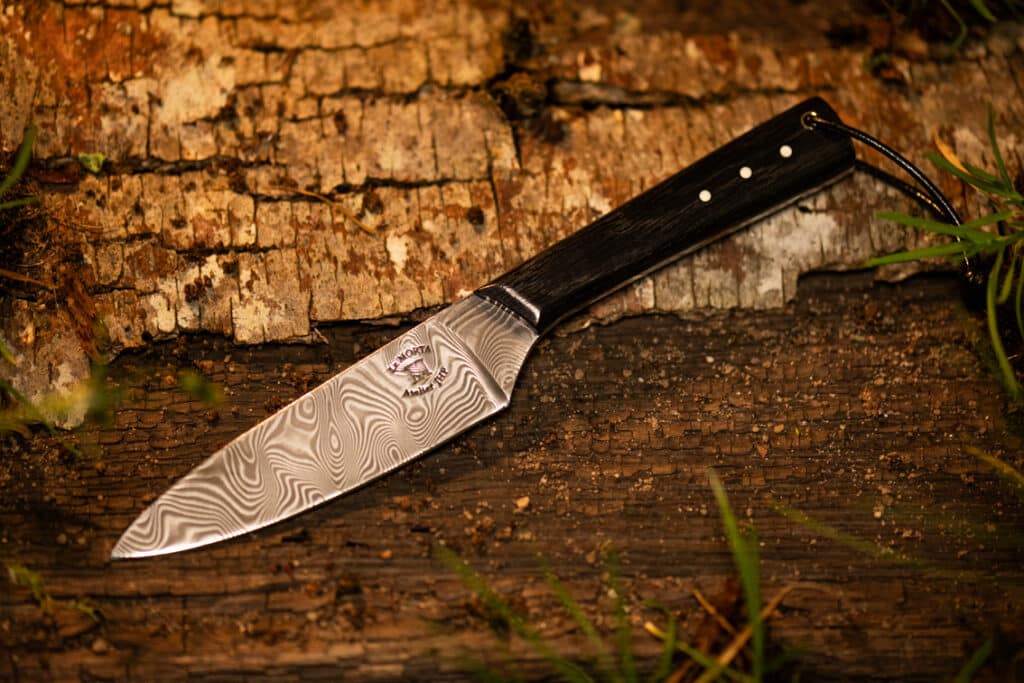« The steel is the heart of the blade, but the heat treatment is its soul. »
The adage directly exposes the ambivalence of comparisons between different steels. Of course, hardness, corrosion resistance, edge retention and ease of sharpening remain key criteria. However, steel in cutlery is by no means an exact science. Rather, it’s a happy alchemy of metallurgical processes, blade grinding, knife use and, above all, how it feels in the palm of your hand. Let’s compare the best steels for knives, but let’s remain objective and practical with the highly subjective opinion of our cutler.
Cutlery steel: the characteristic properties of a good blade
Hardness according to the Rockwell scale
Hardness defines the ability of steel to deform before breaking. The harder it is, the more fragile it is to impact. This may seem strange, but it’s logical, since it bends less.
Take glass, for example: as hard as it is brittle.
In cutlery, the reference measurement is the Rockwell C scale. The Rockwell hardness test is a method for measuring the difference in penetration depth. The test consists of a calibrated diamond cone applied to the steel. Gradually, the contact force is increased. At the end of the test, the indentation left by the indenter determines the Rockwell hardness (HRC).
It’s a simple, non-destructive process. Its speed of execution has earned it the nickname « rapid testing ».
Knives generally offer a hardness of between 54 and 61 HRC.
🔪 At less than 56 HRC, we speak of the standard range: medium-quality table knives.
🔪 Between 56 and 58 HRC, we find kitchen knives and chef’s knives: these are more professional ranges.
🔪 Above 58 and up to 61 HRC, the right balance between hardness and sharpness.
⬇️ Find out more about the opinion of our expert knifemaker below. ⬇️
NB: hardness depends not only on the steel, but also on the heat treatment.
Edge retention and ease of sharpening
A blade’s hardness influences its durability. The more resistant the steel is to breakage, the longer the edge lasts. On the other hand, it makes sharpening more difficult.
A hardness between 58 and 61 HRC gives a very good edge and is relatively easy to sharpen.
In this video, you’ll find our top tips for effective, blade-friendly sharpening.
Corrosion resistance
In the kitchen or outdoors, knife blades have to cope with humidity. Cutting freshly rinsed vegetables or juicy fruit, picking a mushroom in the morning dew or gutting fish just out of the water – these are just some of the activities that expose steel to water.
Hence the importance of its ability to resist corrosion.
Oxygen and water cause a chemical reaction that creates iron oxide, in other words, rust.
Only stainless steel avoids this phenomenon; for the others, your cutler recommends that you dry the blade thoroughly after each use.
Heat treatment
The process of hardening and tempering steel, known as heat treatment, influences the strength of the blade’s cutting edge. A knife’s performance is highly dependent on the quality of its heat treatment.
Remember: heat treatment also influences hardness.
The cutting edge
The emouture is the part of the blade that tapers to the edge of the knife, in other words, the cutting edge. The thinner it is, the more effective the cutting edge, but obviously, the more fragile the blade.
It all depends on the application.
In cooking, for example, a flat edge is preferable to a concave or convex one.
The right steel for every purpose
Depending on the material to be cut, you’ll need a different cutting edge and blade thickness. Try cutting tree bark with a very thin blade and you’ll immediately regret your action.
Knives for the food trade: stainless steel
Most professional blades are used in the kitchen. Skinning knives, boning knives, bleeding knives, filleting knives, trimming knives: they all end up under water and washing-up liquid, out of respect for food regulations.
Chef’s knives, paring knives and table knives all require perfect hygiene.
Rust resistance is therefore the most important factor in the choice of steel.
Fishmongers worry about the effect of salt on their blades.
Butchers, charcutiers and creameries benefit from natural lubrication. When cutting meat fat or cheese, they maintain their blade 😉.
🍴Reminder: RWL34, Damascus and 14c28n steels are stainless. All these alloys contain more than 14% chromium.
For outdoor knives
When choosing a knife for outdoor use, the first criterion to consider is whether it is stainless or not. Steels such as 14c28n, 90mcv8 or RWL34 are ideal for hunting and fishing knives. Multi-purpose folding knives are also corrosion-resistant. The chromium content of the alloy is therefore of vital importance.
🌲Reminder: RWL34, Damascus and 14c28n steels are rustproof. For all that, rough-forged pocket knives love to get away for a hike. Carbon-filled forged steel takes on an authentic character, letting the patina appear on the blade as it is used.
So, here too, it’s a question of choice and sensitivity.
For multi-purpose knives (EDC)
EDC (Every Day Carry) knives are used both indoors and outdoors.
Here, the choice depends on the owner’s tastes. A well-maintained 90cmv8 steel blade (i.e., a simple wipe with a soft cloth after use) offers excellent outdoor performance.
🔪 Reminder: All Morta knife blades have a minimum hardness of 59 HRC.
The different steels for a knife
14c28n steel
A stainless alloy, 14c28n steel is appreciated for its composition, precision and hardness. In fact, it contains manganese, which adds finesse to the steel’s grain, and carbon, which enhances its hardness. Phosphorus and sulfur make it easy to shape. Manufactured by powder metallurgy, its blending is very precise. Finally, heat treatment (austenitization) reinforces its hardness.
In cutlery, 14c28n steel blades are highly resistant to rust, wear and abrasion. They are also perfectly hygienic. Alleima Sandvik (one of the metalworkers who manufacture it) notes « very good » resistance to corrosion.
90mcv8 steel
Also known as O2, 90mcv8 steel is a carbon steel. Knifemakers and metalworkers appreciate its balance of strength and flexibility, as well as its resilience. It offers good durability and is easy to forge.
Heat treatment (forging) can bring it to a hardness of 62 HRC. Its cutting power makes it popular for various industrial applications (shears, threading, reamers, punches, dies, etc.).
It is mainly found on outdoor, hunting and fishing knives. At Couteaux Morta, it graces the Brute de Forge collection. These knives are particularly appreciated by bushcraft, hiking and hunting enthusiasts for their authentic craftsmanship.
RWL34 steel
Named after cutler Robert W Loveless. He used it to manufacture drop-point hollow-point blades and « full tang hollow-point* » blades.
Made tough by molybdenum and vanadium, RWL34 is appreciated for its ease of machining (grinding and polishing). Knifemakers appreciate it for its quality cutting edge.
* : Full tang knife: a knife whose blade extends the full length of the handle.
12c27 steel
Used in standard cutlery, 12c27 steel is annealed and cold-rolled. Sandvik gives it « good resistance » to wear.
X50CRMOV15 steel
Often called « German steel », because that’s where most of it comes from, X50CRM0V15 steel is used for kitchen knives. It contains molybdenum and vanadium, which increase its resistance to corrosion.
With its 15% carbon content, it is very easy to clean with water.
Stainless steel (inox)
Stainless steel or « inox » is the generic term for all steel-based alloys with a :
- chromium exceeds 10.5% ;
- carbon below 1%.
Chromium reacts with oxygen in the air to form a protective film. This surface automatically regenerates itself: self-passivation.
Very tough and water-resistant, it is ideal for outdoor knives, kitchen knives, chef’s knives, paring knives, etc.
Disadvantage: scratches easily.
Damascus steel
Emblematic for its moiré sheen and arabesque appearance, Damascus steel takes its name from the Syrian city of the same name. However, its production originated in Iran.
Well-known in cutlery, Damascus steel is derived (on certain Morta knives) from the combination of RWL34 and PMC27 steels.
Powder metallurgy, the process behind Damascus, ensures excellent sharpness, easy sharpening and good resistance to corrosion and cracking.
Good to know 😉
With a view to continuous improvement, Jean-Henri, our cutler, will soon have some pleasant surprises in store for us regarding the composition of the steel used in Morta Damascus knives.
Comparative guide to Morta Knife blade steels
We’ll refrain from making any value judgements, as the following paragraph explains our cutler’s position. However, it is interesting to note the equivalence in hardness between the steels offered in the Morta Knife collections.
| Steel type | Hardness | Stainless steel | Chromium content | Collection |
| 90mcv8 | 59-60 | No | 0.2 à 0.35 | Rough Forged Knives |
| RWL34 | 59 à 60 | Yes | 14 | Damascus folding knife |
| X50CRMOV15 | 57 | Yes | 15 | Table knives |
| 14c28n | 59 | Yes | 14.5 | Massive Morta knife Chef’s knife Office knife Oyster knife Morta Back Pump Knife |
What’s the best steel for a knife? The opinion of our cutlery expert
Jean-Henri Pagnon, our cutler, refuses to reduce the quality of a knife to the hardness of its blade. A 70 HRC blade would be virtually impossible to sharpen 😫. The softer the steel, the easier it is to sharpen, but the less it holds its edge.
« Let’s say that between 58 and 61 HRC, the blade combines good hardness, a long-lasting edge and easy sharpening. »
His best knifemaking advice is to find the knife you’re most comfortable with. Perhaps it’s the one your grandfather passed down to you, or the one you received for Father’s Day. For some, the best knife is simply the paring knife they use every day.
A friend and cutlery partner, Emmanuel FAYET, recently said:
« There are no bad steels. There are only bad grindings and bad heat treatments ».
If we asked you which car was the best… Ferrari would be ridiculous in the Brière marshes. The old Land Rovers in the workshop would be hilarious on a GP circuit. A family much prefers a minivan. When it comes to knives, it’s all the same. It all depends on use and sensitivity.
A handle with a patina of wood (preferably Morta 😉 ), a blade accustomed to your sharpening gesture, an opening mechanism that your fingers know by heart. In short, a knife is also a symbolic object that accompanies you every day. No matter what steel the blade is made from, it’s your knife, period!
As you can see, it would be unfair to declare one steel better than another for making a knife blade. The mechanical properties of alloys do not reflect edge efficiency or durability. The knife is a complex object (dare we say a being?) that cannot be summed up in a few numerical measurements. It symbolizes a way of life, a person, a memory.
So, « what better steel? ». Just think, what a funny question (which we hope to have answered with this article 😜).
Article summary
What are the most important criteria for assessing knife steel?
The essential criteria for judging the quality of a knife steel are :
- hardness measured on the Rockwell scale (HRC) ;
- corrosion resistance ;
- long-term edge retention;
- ease of sharpening.
These characteristics determine the efficiency and longevity of the steel blade under various conditions of use.
How does heat treatment influence the performance of a knife blade?
Heat treatment, which involves heating and quenching the steel, is fundamental to optimizing the steel’s internal structure, which directly affects its hardness, flexibility and resistance to breakage.
Proper heat treatment maximizes hardness while retaining a certain resilience, essential to prevent the blade from becoming too brittle.
What are the implications of steel hardness on knife performance?
The hardness of a steel, assessed according to the Rockwell C (HRC) scale, influences the blade’s ability to maintain a sharp edge. Knives with a hardness of 58 to 61 HRC offer a good compromise between long-lasting sharpness and ease of sharpening.
Harder steel resists wear better, but can be difficult to sharpen and more likely to break under stress.
Why are certain steels, such as 14c28n and X50CRMOV15, preferred for cook's knives?
14c28n and X50CRMOV15 steels are particularly valued for kitchen knives because of their good corrosion resistance and balance between hardness and sharpness.
These steels contain levels of chromium that promote the formation of a protective layer against rust.
What type of steel is recommended for knives intended for outdoor use, and why?
For hunting or bushcraft knives, steels such as 14c28n, 90mcv8 or RWL34 are recommended, as they combine durability with exceptional corrosion resistance.
These stainless steels are able to withstand harsh outdoor conditions and maintain an effective cutting edge.
What sets Damascus steel apart from other cutlery steels?
Damascus steel is renowned for its aesthetics and performance. It is manufactured by bending and forging several types of steel together, creating distinctive patterns.
This method, in addition to embellishing the blade, also offers an advantageous combination of hardness and flexibility, making Damascus steel blades ideal for applications where sharpness and mechanical strength are crucial.
How to choose the right steel for a knife according to the expertise of a professional cutler?
According to our expert knifemaker, the choice of steel should be guided not only by the alloy’s technical characteristics, but also by its intended use and personal preferences.
He suggests selecting a knife that feels good in the hand and meets the specific needs of its user, whether in terms of weight, blade shape, or ease of maintenance.
What impact does carbon content have on the properties of a knife steel?
A steel with a high carbon content can achieve high hardness, which is essential for maintaining a good cutting edge over long periods.
However, high-carbon steels are less resistant to corrosion and may require more rigorous care, such as drying after each use and regular application of oil to protect the blade.


